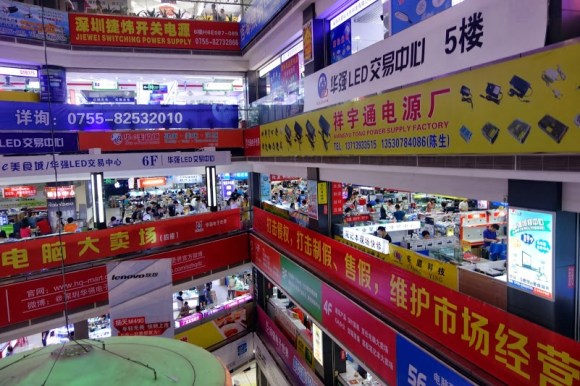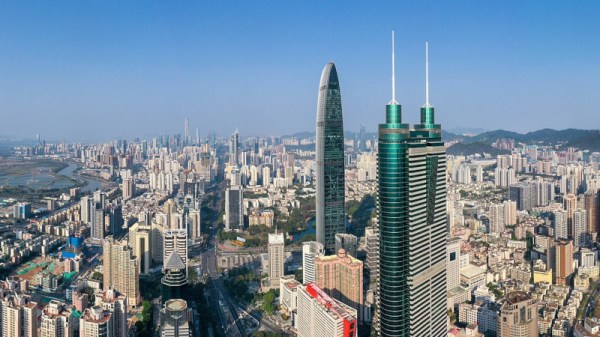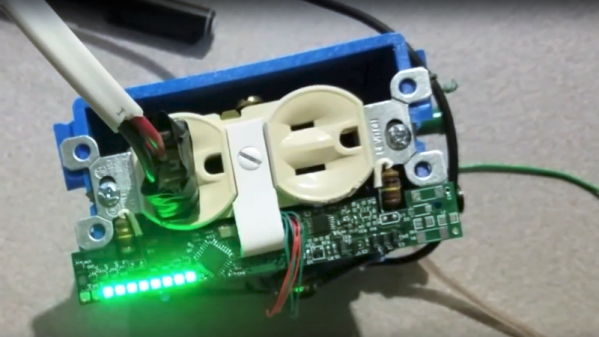Are robotaxis poised to be the Next Big Thing™ in North America? It seems so, at least according to Goldman Sachs, which issued a report this week stating that robotaxis have officially entered the commercialization phase of the hype cycle. That assessment appears to be based on an analysis of the total ride-sharing market, which encompasses services that are currently almost 100% reliant on meat-based drivers, such as Lyft and Uber, and is valued at $58 billion. Autonomous ride-hailing services like Waymo, which has a fleet of 1,500 robotaxis operating in several cities across the US, are included in that market but account for less than 1% of the total right now. But, Goldman projects that the market will burgeon to over $336 billion in the next five years, driven in large part by “hyperscaling” of autonomous vehicles.
market7 Articles
Hackers Beware: Shenzhen Is Closing
If you’re among those of us with immediate plans for a PCB or parts order from China, watch out – Shenzhen just recently got put on a week-long lockdown. Factories, non-essential stores and public places are closed, and people are required to spend time at home – for a city that makes hardware thrive, this sounds like a harsh restriction. Work moves to remote where possible, but some PCB fabs and component warehouses might not be at our service for at least a week.
It might be puzzling to hear that the amount of cases resulting in closures is as low as 121, for a city of 12.6 million people. The zero-tolerance policy towards COVID has been highly effective for the city, with regular testing, adhered-to masking requirements and vaccinations – which is how we’ve been free to order any kinds of boards and components we needed throughout the past two years. In fact, 121 cases in one day is an unprecedented number for Shenzhen, and given their track record and swift reaction, it is reasonable to expect the case count dropping back to the regular (under 10 cases per day) levels soon.
Not all manufacturing facilities are located in Shenzhen, either. Despite what certain headlines might have you believe, supply chain shortages aren’t a certainty from here. A lot of the usual suspects like PCBWay and JLCPCB are merely reporting increased lead times as they reallocate resources, and while some projects are delayed for now, a lot of fabs you’d use continue operating with minor delays at most. SeeedStudio has its operations impacted more severely, and your Aliexpress orders might get shipped a bit later than usual – but don’t go around calling this a Chinese New Year v2 just yet. For those who want to keep a closer eye on the situation and numbers, the [Shenzhen Pages] Twitter account provides from-the-ground updates on the situation.
Wondering how your supply chain might be affected? We’ve talked about this way back in February 2020, addressing then-warranted worries that Chinese New Year would grow into a longer disruption than planned due to COVID becoming into a factor to manage. If you’re yet to discover the significance of Shenzhen, books have been written on this marvellous city, where you can build a successful hardware company in a week’s time. We’ve even had a meetup there once!
Header image: Charlie fong, CC BY-SA 4.0.
Hackaday Links: December 27, 2020
We’re always pleased to see one of our community’s projects succeed, and we celebrate that success in whatever what it comes. But seeing a company launched to commercialize an idea that started as a Hackaday.io project and a Hackaday Prize entry is especially gratifying. So we were pleased as punch to see that MAKESafe Tools has managed to bring the idea of add-on machine tool braking to market. We’d love to add this to several tools in our shop. Honestly, of all the terrifying ways machine tools can slice, dice, and shred human flesh asunder, we always considered the lowly bench grinder fairly low-risk — and then we had a chance to “Shake Hands with Danger.”
Another great thing about the Hackaday community is the way we all try to keep each other up to speed on changes and news that affects even our smallest niches. Just last week Tom Nardi covered a project using the venerable TI eZ430-Chronos smartwatch as a makeshift medical alert bracelet for a family member. It’s a great application for the proto-smartwatch, but one eagle-eyed commenter helpfully pointed out that TI is shutting down their processors wiki in just a couple of weeks. The banner at the top of each page warns that the wiki is not read-only and that any files needed should be downloaded by January 15. Also helpfully, subsequent comments include instructions to download the entire wiki and a torrent link to the archive. It’s always sad to see a platform lose support, especially one that has gained a nice following, but it’s heartening to see the community pull together to continue to support each other like this.
We came across an interesting article this week that’s was a fascinating glimpse into how economic forces shape and drive technological process, and vice versa. It turns out that some of the hottest real estate commodities these days are the plots of land occupied by AM radio stations serving metropolitan markets. It’s no secret that terrestrial radio in general, and AM radio in particular, are growing increasingly moribund, and the infrastructure needed to keep them on the air is getting harder and harder to justify. Chief among these are the large tracts of land devoted to antenna farms, which are often located in suburban and exurban areas near major cities. They’re tempting targets for developers looking to plunk down the physical infrastructure needed to support “New Economy” players like Amazon, which continue to build vast automated warehouses in areas that are handy to large customer bases. It’s a bit sad to watch a once mighty industry unravel and be sold off like this, but such is the nature of progress.
And finally, you may recall a Links article mention a few weeks back about a teardown of a super-sized IBM processor module. A quarter-million dollar relic of the 1990s, the huge System/390 module was an engineering masterpiece that met an unfortunate end at the hands of EEVblog’s Dave Jones. As a follow-up, Dave teamed up with fellow YouTuber CPU Galaxy to take a less-destructive tour of the module using X-ray analysis. The level of engineering needed for a 64-layer ceramic backplane is astonishing, and Dave’s play-by-play is pretty entertaining too. As a bonus, CPU Galaxy has some really interesting stuff; his place is basically a museum of vintage tech, and he just earned a new sub.
Ask Hackaday: What’s Your Coronavirus Supply Chain Exposure?
In whichever hemisphere you dwell, winter is the time of year when viruses come into their own. Cold weather forces people indoors, crowding them together in buildings and creating a perfect breeding ground for all sorts of viruses. Everything from the common cold to influenza spread quickly during the cold months, spreading misery and debilitation far and wide.
In addition to the usual cocktail of bugs making their annual appearance, this year a new virus appeared. Novel coronavirus 2019, or 2019-nCoV, cropped up first in the city of Wuhan in east-central China. From a family of viruses known to cause everything from the common cold to severe acute respiratory syndrome (SARS) in humans, 2019-nCoV tends toward the more virulent side of the spectrum, causing 600 deaths out of 28,000 infections reported so far, according to official numbers at the time of this writing.
(For scale: the influenzas hit tens of millions of people, resulting in around four million severe illnesses and 500,000 deaths per season, worldwide.)
With China’s unique position in the global economy, 2019-nCoV has the potential to seriously disrupt manufacturing. It may seem crass to worry about something as trivial as this when people are suffering, and of course our hearts go out to the people who are directly affected by this virus and its aftermath. But just like businesses have plans for contingencies such as this, so too should the hacking community know what impact something like 2019-nCoV will have on supply chains that we’ve come to depend on.
Continue reading “Ask Hackaday: What’s Your Coronavirus Supply Chain Exposure?”
Smart Outlet Cover Offers Lessons On Going From Project To Product
Going from idea to one-off widget is one thing; engineering the widget into a marketable product is quite another. So sometimes it’s instructive to take an in-depth look at a project that was designed from the get-go to be a consumer product, like this power indicating wall outlet cover plate. The fact that it’s a pretty cool project helps too.
Although [Vitaliy] has been working on this project for a while, he only recently tipped us off to it, and we’re glad he did because there’s a lot to learn here. His goal was to build a replacement cover for a standard North American power outlet that indicates how much power is being used by whatever is plugged into it. He set constraints that included having everything fit into the familiar outlet cover form factor, as well as to not require any modification to the existing outlet or rewiring, so that a consumer can just remove the old cover and put on the new one. Given the extremely limited space inside an outlet cover, these were significant challenges, but [Vitaliy] found a way. Current is sensed with two inductors positioned to sense magnetic flux within the outlet, amplified by a differential amp, and power use is calculated by an ATmega328 for display on 10 LEDs. Power for the electronics is tapped right from the outlet wiring terminals by spring clips, and everything fits neatly inside the cover.
It’s a great design, but not without issues. We look forward to seeing [Vitaliy] tackle those problems and bring this to market. For more on what it takes to turn a project into a product, check out our own [Lewin Day]’s story of bringing a guitar effects pedal to market.
Continue reading “Smart Outlet Cover Offers Lessons On Going From Project To Product”
The Electronics Markets Of Ho Chi Minh City, Vietnam
When we think about world-famous electronics markets in Asia, usually Shenzhen, Tokyo’s Akihabara, or Shanghai’s Beijing Road come to mind.
There’s another market that I’ve had my eye on for a few years: Nhật Tảo market in Ho Chi Minh City, Vietnam. It might not be as large or accessible as the more well-known markets, but it’s very much worth a visit if you’re in the area. I decided it was time to hop on my red motorbike (red things go faster) and give you a short tour of the central market, as well as some more hobbyist-friendly options.
Continue reading “The Electronics Markets Of Ho Chi Minh City, Vietnam”
Touring Component Markets In Shenzhen

[Al] recently returned from a trip to China. While there he toured some of the component markets in Shenzhen, the electronics assembly epicenter of the world. While he doesn’t focus too closely on what is actually being sold there, we found his description of the markets themselves and other notable attractions around the area quite interesting.
Shenzhen is different from some of the other component wonderlands we’ve heard about ([Ian Lesnet’s] tour of Akihabara in Japan comes to mind). First of all it may be a bit more difficult to get there. US Citizens need a Visa to enter China, and must fly to Hong Kong and take a ferry to the mainland. [Al] reports that the traffic is horrendous and rush-hour can turn a ten mile ride that usually takes ninety minutes into a three hour tour… a three hour tour!
The side affect of the market being out of the way is that the prices aren’t as inflated as they may be in more geek-tourist-friendly locations. That being said it also sounds like the vendors are interested in selling you a few thousand units rather than a single component. Follow the link at the top for the market tour, a stop at Seeed Studios (who will apparently sell you a map of the best markets to visit), and the rest of the attractions that [Al] encountered.
















